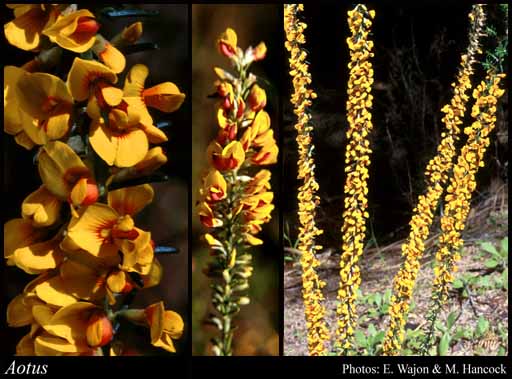- Reference
- Ann.Bot. 1:504 (1805)
- Name Status
- Current

Scientific Description
Family Papilionaceae. Mirbelieae.
Sometimes included in Leguminosae.
Habit and leaf form. Shrubs (often with virgate branches). Plants unarmed. Leaves cauline. Plants with neither basal nor terminal concentrations of leaves. Leaves alternate, or whorled; when whorled, generally 3 per whorl; petiolate, or subsessile, or sessile; non-sheathing; simple; epulvinate. Leaf blades dorsiventral; entire; flat; without cross-venules. Leaves ‘usually’ without stipules. Leaf blade margins entire, or dentate; revolute. Leaf anatomy. Complex hairs present, or absent (? — peltate hairs absent).
Reproductive type, pollination. Fertile flowers hermaphrodite. Unisexual flowers absent. Plants hermaphrodite. Entomophilous.
Inflorescence and flower features. Flowers solitary, or aggregated in ‘inflorescences’; not crowded at the stem bases; 1–3 per axil; in racemes. Inflorescences leafy racemes, or the flowers 1–3 in axillary clusters. Flowers shortly pedicellate; bracteate. Bracts deciduous (scarious, broad, concave, caducous). Flowers ebracteolate; very irregular; zygomorphic. The floral asymmetry involving the perianth, or involving the perianth and involving the androecium. Flowers papilionaceous; tetracyclic. Floral receptacle developing a gynophore, or with neither androphore nor gynophore. Free hypanthium present, or absent. Hypogynous disk present; intrastaminal; annular. Perianth with distinct calyx and corolla; 10; 2 -whorled; isomerous. Calyx present; 5; 1 -whorled; gamosepalous; five lobed (ribbed). Calyx lobes about the same length as the tube. Calyx imbricate; exceeded by the corolla; bilabiate (the upper pair of lobes broader and more connate); non-fleshy; persistent; non-accrescent; with the median member anterior. Corolla present; 5; 1 -whorled; appendiculate, or not appendiculate. Standard not appendaged. Corolla polypetalous, or partially gamopetalous. 2 of the petals joined. The joined petals anterior (the keel members). The wings of the corolla free from the keel; not laterally spurred. Standard ‘normally’ developed; emarginate. Keel incurved, about equalling the wings; not long-acuminate/beaked; neither coiled nor spiralled; not bent and beaked. Corolla imbricate; yellow, or yellow and red, or yellow, red, and brown; deciduous; non-accrescent. Petals all rather long clawed. Androecial members definite in number. Androecium 10. Androecial sequence determinable, or not determinable. Androecial members free of the perianth; all equal to markedly unequal; free of one another; 1 -whorled. Androecium exclusively of fertile stamens. Stamens 10; all more or less similar in shape; diplostemonous; both opposite and alternating with the corolla members; filantherous. Anthers separate from one another to connivent; all alike; dehiscing via longitudinal slits; latrorse, or introrse; tetrasporangiate. Gynoecium 1 carpelled. The pistil 1 celled. Carpels reduced in number relative to the perianth. Gynoecium monomerous; of one carpel; superior. Carpel stylate. Style filiform. Stigmatic tissue terminal. Carpel 2 ovuled. Placentation marginal. Ovary sessile to stipitate. Stigmas punctiform (minute). Ovules short funicled; biseriate.
Fruit and seed features. Fruit stipitate, or subsessile; non-fleshy. The fruiting carpel dehiscent; a legume. Pods globose to somewhat elongated (circular, ovate, obovate, etc., in outline); not triangular; becoming inflated, or not becoming inflated; more or less flat, or somewhat compressed, or terete; not constricted between the seeds; not transversely septate; wingless; not internally hairy. Valves of the dehisced pod not twisted. Fruit 1 celled. Dispersal unit the seed. Fruit 2 seeded. Seeds lobed, not triangular; not mucous; reniform in outline; ‘usually’ non-arillate. Embryo bent (radicle inflexed). Testa non-operculate; homogeneous in colour.
Geography, cytology, number of species. 2n = 14, 16. A genus of 15 species; 10 species in Western Australia.